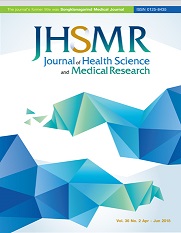Fractured Metallic Tracheostomy Tube: Report of a Fractographic Study
DOI:
https://doi.org/10.31584/jhsmr.2021789Keywords:
Corrosion, stainless steel, tracheostomy tube fractureAbstract
Objective: To investigate the cause of a broken metallic tracheostomy tube.
Material and Methods: In this study, we performed a fractographic investigation of a broken tracheostomy tube from an elderly patient using surface visualization, scanning electron microscopy, energy dispersive X-ray spectroscopy, and chemical composition analysis using X-ray fluorescent and metallographic testing.
Results: Surface visualization revealed multiple corrosive pits which were confirmed by liquid penetrant testing. Scanning electron microscopy and energy dispersive X-ray spectroscopy revealed the chemical composition of the tube to be an austenitic chromium-nickel-manganese stainless steel alloy. Metallographic analysis suggested that the fracture site originated from the inner surface from intergranular corrosion.
Conclusion: The evidence suggests that the corrosion resistance properties of this material might not be suitable for long term use in the human trachea. Higher grade stainless steel or more frequent device change is recommended.
References
Herrag M, Sajiai H, Rochdi Y, Lahmiti S, Dannaoui Y, Raji A, et al. Flexible bronchoscopic removal of a fractured metallic tracheostomy tube. J Bronchology Interv Pulmonol 2011;18: 164-7.
Jacobs SE. Chemical disinfection. Some aspects of the dynamics of disinfection. J Pharm Pharmacol 1960;12(Suppl): 9-18.
Srirompotong S, Kraitrakul S. Fractured inner tracheostomy tube: an unusual tracheobronchial foreign body. Srinagarind Med J 2001;16:223-5.
Piromchai P, Lertchanaruengrit P, Vatanasapt P, Ratanaanekchai T, Thanaviratananich S. Fractured metallic tracheostomy tube in a child: a case report and review of the literature. J Med Case Rep 2010;4:234.
So-Ngern A, Boonsarngsuk V. Fractured metallic tracheostomy tube: A rare complication of tracheostomy. Respir Med Case Rep 2016;19:46-8.
Hryniewicz T, Rokicki R, Rokosz K. Corrosion characteristics of medical-grade AISI Type 316L stainless steel surface after electropolishing in a magnetic field. Corrosion 2008;64:660-5.
Ulrich Heubner W. Stainless steel - when health comes first. Brussels: Euro Inox; 2009.
Guerra-Fuentes L, García-Sánchez E, Juárez-Hernández A, Hernández-Rodríguez M. Failure analysis in 316L stainless steel supracondylar blade plate. Eng Fail Anal 2015;57: 243-7.
Hernandez-Rodriguez A. Failure analysis in 316L stainless steel supracondylar blade plate. Eng Fail Anal 2015;57:243-7.
























